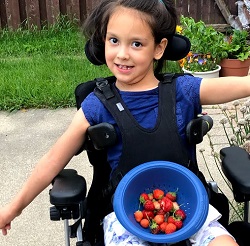Access? Yes. Included? Not always.
by Bernhard
 Our daughter Elena has a standing physical therapy appointment every Saturday at the Shirley Ryan Ability Lab, which is one of the top rated rehab hospitals in the world and is located just north of downtown Chicago. Fortunately, it’s only a 30 minute drive from our house.
Our daughter Elena has a standing physical therapy appointment every Saturday at the Shirley Ryan Ability Lab, which is one of the top rated rehab hospitals in the world and is located just north of downtown Chicago. Fortunately, it’s only a 30 minute drive from our house.
When we pull into the covered valet station, we’re protected from any inclement weather. That means we lower the ramp on our accessible minivan, roll Elena on to the sidewalk, and hand the keys to the valet, which is only 3 dollars with a valid handicapped placard. Try finding that any other place in Chicago!
With ease, we enter the building through automated doors, navigate the wide hallways, roll over incredibly smooth floors, and ascend to the 18th floor for our regular appointment. It’s a stress free way to spend our morning and we don’t have to worry about figuring out the location of the accessible entrance, wondering if they accommodate wheelchairs, finding out if there is an elevator or lift, or checking if there are any stairs.
As July celebrates the anniversary of the Americans with Disabilities Act, it has become clear to me that most places are accessible, which is good, but few places are truly disability friendly. What I mean by this is that often institutions have a “good enough” or tokenistic attitude toward accessibility that often prevents our family from having a choice of where we enter or exit a building, where we sit, or how we ascend or descend to different levels of a building.
When we go to the movies, we sit in accessible seats, which are either in the last row or on the side. When we enter a building, the accessible entrance is seldom on the front of the building, but rather on the side or in the back, out of plain site. We often enter buildings using doors that are not automated and were it not for my wife or me accompanying our daughter, Elena would not be able to enter.
So, do we have access? Yes. Are we included? Not always. When the dignity of choosing where to enter and exit a building or where to sit is compromised, I wonder how truly inclusive our society is?
Before I had a child with a disability, I believed that our country did a pretty decent job of including those with mobility needs. However, as a parent of a child in a wheelchair, I’ve learned first-hand that there is clearly a great deal of growth that needs to happen in order to call ourselves an inclusive society.
The village we live in made the news when it decided to move the ramp from the side of one of our park district buildings to the front. Of course I applaud their efforts to implement a plan to create a more inclusive society, but I want to live in a world where this is not a headline, just regular practice.







July 22nd, 2019 at 2:50 pm
Thanks Mike!
I’m also concerned about how electric scooters are going to litter the sidewalks and prevent access to curb cuts or how sidewalk/outdoor dining affects safe passage.
July 19th, 2019 at 12:24 pm
Love this post, and your honesty–I, too, thought we did a good job with accessibility/inclusion–before I had a child in a wheelchair. Then I realized, really, it’s viewed more as an extra credit/bonus point kind of thing instead of a baseline minimum thing. Thanks for writing this.